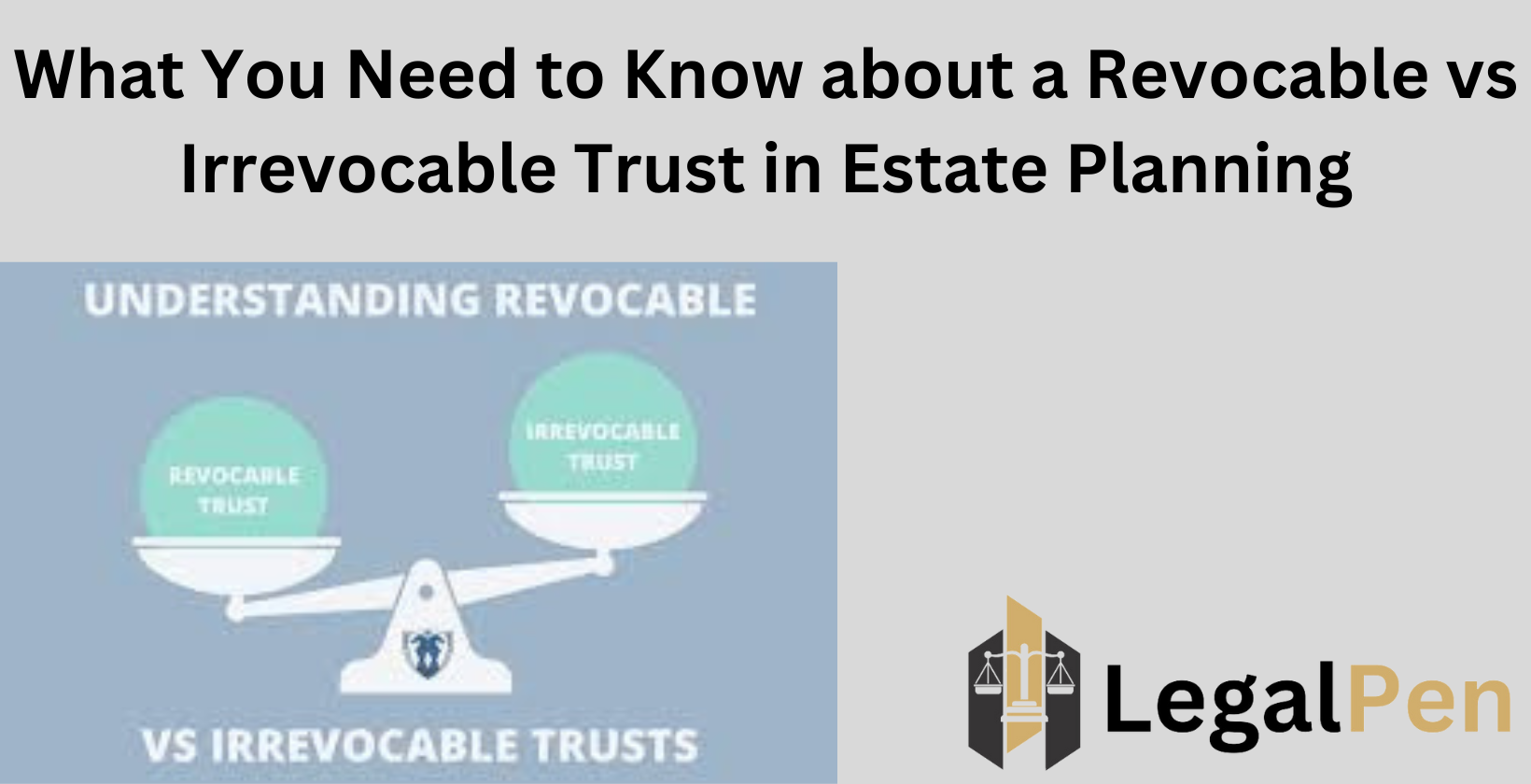Estate planning is essential for safeguarding your assets and ensuring they are distributed according to your wishes. Among the most effective tools are revocable and irrevocable trusts, each designed to meet different financial and personal objectives. Understanding their key features, benefits, and differences is crucial for selecting the trust that aligns with your needs and goals. In this guide, we explore the essentials of these trusts, helping you make informed decisions for your estate plan.
What is a Revocable Trust?
A revocable trust is a legal arrangement that allows the creator, also known as the grantor, to manage assets during their lifetime while retaining the ability to modify, amend, or revoke the trust at any time. This type of trust provides flexibility and control over the assets placed within it.
For example, an individual can establish a revocable trust to avoid probate and designate beneficiaries for their estate, with the option to change beneficiaries or asset allocations as circumstances evolve.
Benefits of a Revocable Trust
A revocable trust offers several advantages, making it a popular choice for estate planning. These benefits provide flexibility, control, and efficiency in managing and distributing assets. Key benefits include:
- Avoidance of Probate: A revocable trust allows assets to bypass the probate process, ensuring faster and more private asset distribution to beneficiaries.
- Flexibility: The grantor retains the ability to modify or revoke the trust as their needs or circumstances change.
- Continued Control of Assets: The grantor can act as the trustee, maintaining full control over the management of trust assets during their lifetime.
- Privacy: Unlike a will, which becomes a public document during probate, a revocable trust keeps the details of the estate private.
- Incapacity Planning: The trust includes provisions for the management of assets if the grantor becomes incapacitated, avoiding the need for court-appointed guardianship.
What Are the Disadvantages of a Revocable Trust?
While a revocable trust offers flexibility and control, it comes with certain limitations that may impact its effectiveness in some estate planning scenarios. These include:
- Lack of Asset Protection: Assets in a revocable trust are not shielded from creditors or lawsuits, as the grantor retains ownership and control.
- No Tax Benefits: A revocable trust does not provide tax advantages during the grantor’s lifetime, as the assets are still considered part of their taxable estate.
- Ongoing Costs: Establishing and maintaining a revocable trust may involve legal fees, administrative expenses, and potential costs for amendments.
- Complexity: Properly funding the trust requires transferring titles and assets, which can be time-consuming and complicated.
What Is an Irrevocable Trust?
An irrevocable trust is a legal arrangement where the grantor permanently transfers assets into the trust, relinquishing ownership and control. Unlike a revocable trust, it cannot be modified, amended, or revoked without the consent of the beneficiaries or a court order.
For example, an individual may create an irrevocable trust to protect assets from creditors, reduce estate taxes, or provide for long-term care planning. Once the trust is established, the assets are no longer considered part of the grantor’s estate, offering greater financial security and protection.
What Are the Benefits of an Irrevocable Trust?
An irrevocable trust offers several advantages for those seeking long-term asset protection and tax benefits. By permanently transferring ownership of assets, the grantor can achieve financial security and estate planning goals. The benefits include:
- Asset Protection: Assets placed in an irrevocable trust are shielded from creditors, lawsuits, and other financial liabilities, as they are no longer considered the grantor’s property.
- Tax Advantages: An irrevocable trust can reduce estate taxes and income taxes by removing the assets from the taxable estate, providing significant financial savings.
- Preservation of Wealth: This type of trust ensures that assets are preserved and managed for the long-term benefit of beneficiaries, safeguarding them from mismanagement or financial risks.
- Eligibility for Government Benefits: Assets in an irrevocable trust may not count against eligibility for certain government programs, such as Medicaid, which can be beneficial for long-term care planning.
- Charitable Giving: An irrevocable trust can facilitate structured charitable contributions, offering both tax benefits and a lasting legacy.
What Are the Disadvantages of an Irrevocable Trust?
While an irrevocable trust provides significant benefits, it comes with certain drawbacks that may limit its appeal depending on individual circumstances. These disadvantages include:
- Loss of Control: The grantor gives up ownership and control of the assets placed in the trust, leaving decisions to the trustee.
- Irreversibility: Once established, changes to the trust are difficult or impossible without beneficiary consent or court approval.
- Complexity and Costs: Setting up and managing an irrevocable trust requires careful legal and financial planning, which can be expensive and time-consuming.
- Limited Access to Assets: The grantor cannot freely access the assets once they are transferred to the trust, which may be a drawback in cases of unexpected financial needs.
What Are the Key Differences Between Revocable and Irrevocable Trusts?
Revocable and irrevocable trusts serve distinct purposes in estate planning, differing primarily in flexibility, control, and legal implications. The key differences include:
- Flexibility: A revocable trust can be amended, modified, or revoked by the grantor during their lifetime. An irrevocable trust, once established, cannot be altered without the consent of beneficiaries or a court order.
- Control: In a revocable trust, the grantor retains full control of the assets. In an irrevocable trust, the grantor relinquishes control, with the trustee managing the assets independently.
- Asset Protection: Assets in a revocable trust are not protected from creditors or lawsuits, as they remain part of the grantor’s estate. Irrevocable trusts provide strong asset protection by legally separating the assets from the grantor’s ownership.
- Tax Implications: A revocable trust offers no tax advantages, as assets are still part of the grantor’s taxable estate. Irrevocable trusts can reduce estate and income taxes by removing the assets from the taxable estate.
- Privacy After Death: Both trusts help avoid probate, but irrevocable trusts may offer additional privacy during the grantor’s lifetime since the assets are no longer directly tied to them.
What Are Common Situations Where Revocable and Irrevocable Trusts May Be Used?
Revocable and irrevocable trusts are tailored for different financial and personal objectives, making them suitable for specific situations. Here are common scenarios for each type:
- Revocable Trusts:
o Avoiding Probate: A revocable trust is ideal for individuals who want their assets to bypass the probate process for faster and private distribution.
o Incapacity Planning: People who wish to ensure seamless management of their assets if they become incapacitated often use revocable trusts.
o Flexibility Needs: Individuals who anticipate changes to their beneficiaries or asset allocations use revocable trusts for ongoing adjustments.
Example: A family with young children might use a revocable trust to provide for them, knowing they can amend the trust as the children grow.
- Irrevocable Trusts:
o Asset Protection: High-net-worth individuals seeking to protect assets from creditors and lawsuits often use irrevocable trusts.
o Tax Planning: People who aim to reduce estate taxes or gift taxes use irrevocable trusts to remove assets from their taxable estate.
o Medicaid Eligibility: Individuals planning for long-term care often use irrevocable trusts to preserve assets while qualifying for Medicaid.
o Charitable Giving: Those wanting to make structured donations while enjoying tax benefits use irrevocable trusts.
Example: A business owner might use an irrevocable trust to protect the family business from creditors while passing it tax-efficiently to future generations.
Which Trust Is Right for You?
The choice between a revocable and irrevocable trust depends on your specific financial goals, asset protection needs, and estate planning priorities. Consider the following factors to determine which trust is best suited for your situation:
- Revocable Trust:
o You want flexibility: A revocable trust allows you to make changes, add or remove assets, and modify beneficiaries during your lifetime.
o You want to avoid probate: This trust is ideal if your primary goal is to streamline the distribution of assets and maintain privacy after your passing.
o You prefer control: A revocable trust lets you retain full control over your assets while you are alive.
Example: Someone who expects changes in family dynamics, such as remarriage or the birth of children, might choose a revocable trust for adaptability.
- Irrevocable Trust:
o You need asset protection: An irrevocable trust shields your assets from creditors, lawsuits, and financial liabilities.
o You want to reduce taxes: If you aim to minimize estate or gift taxes, an irrevocable trust can help by removing assets from your taxable estate.
o You are planning for long-term care: This trust can preserve your assets while ensuring eligibility for Medicaid or other government benefits.
Example: A person with significant wealth might use an irrevocable trust to protect assets for heirs while reducing tax burdens.
To make the best decision, evaluate your current and future financial needs, consult an estate planning attorney, and consider how much control you are willing to relinquish over your assets.
Why Is It Important to Review Your Revocable Trust Regularly?
Regularly reviewing your revocable trust is essential to ensure that it reflects your current wishes, life changes, and any shifts in the law. Some key reasons to review your trust include:
- Life Changes: Major life events, such as marriage, divorce, the birth of children, or the death of a beneficiary, may require updates to your trust to ensure that it still aligns with your goals.
- Changes in Assets: If you acquire new assets or sell existing ones, you may need to update the trust to include or exclude these changes.
- Changes in Laws: Estate and tax laws may evolve, potentially impacting your trust’s effectiveness. Regular reviews help ensure that your trust remains legally compliant and maximizes its benefits.
- Beneficiary Changes: As relationships and circumstances change, you may wish to modify beneficiaries or the way your assets are distributed.
What Are Common Mistakes to Avoid When Setting Up a Trust?
Setting up a trust requires careful planning to ensure that it meets your estate planning goals. Here are some common mistakes to avoid:
- Failing to Fund the Trust: One of the most common mistakes is not transferring assets into the trust after it is created. Without funding, the trust has no legal effect, and assets will still go through probate.
- Choosing the Wrong Trustee: Selecting a trustee who is not trustworthy, lacks the skills to manage the trust, or has conflicts of interest can lead to poor management of the trust’s assets.
- Not Updating the Trust: Life changes, such as marriage, divorce, the birth of children, or the death of a beneficiary, require regular updates to the trust. Failing to make these changes may result in unintended beneficiaries or outdated provisions.
- Inadequate Tax Planning: Trusts can have significant tax implications, and improper planning may lead to higher estate or income taxes. It’s crucial to consult a tax professional to optimize the trust for tax efficiency.
- Not Addressing Incapacity: Many people overlook adding provisions for incapacity. A revocable trust should include a clause for successor trustees to step in if the grantor becomes unable to manage the trust.
- Leaving Out Key Assets: When creating a trust, be sure to list all assets, including real estate, bank accounts, and investments. Failing to include key assets can result in them being left out of the trust and subject to probate.
- Overcomplicating the Trust: Some individuals create overly complex trust structures that may confuse the trustee and beneficiaries. Keep the trust clear and simple to ensure it is properly executed.
How Do You Amend or Revoke a Revocable Trust?
Amending or revoking a revocable trust allows you to adjust the terms or even dissolve the trust entirely, depending on your changing needs. Here’s how to do it:
- Amending a Revocable Trust:
- Create an Amendment: To amend a trust, you can create a formal document known as a “trust amendment” that details the changes you want to make. This could involve adding or removing beneficiaries, changing the distribution of assets, or modifying provisions related to the trustee.
- Sign and Notarize: The amendment must be signed by the grantor and usually notarized to make it legally binding. Some states may require witnesses.
- Distribute the Amendment: After making the amendment, provide copies to the trustee and any other relevant parties to ensure everyone is aware of the changes.
- Create a Revocation Document: To revoke a trust, you must create a formal revocation document that states you are canceling the trust. This document should clearly identify the trust and its date of creation.
- Notify the Trustee: Once the trust is revoked, inform the trustee and any other involved parties. It may be necessary to transfer the assets out of the trust and back to the grantor’s name.
- Destroy or Update Trust Documents: If desired, destroy the original trust document to prevent confusion. Alternatively, if the trust is being replaced with a new one, ensure the new trust documents are properly executed.
Meet the Author
Annie L – Distinguished linguist at LegalPen
Annie is a distinguished linguist at LegalPen, bringing a unique blend of legal expertise and linguistic precision to her work. She earned her Juris Doctor degree from Yale University in New Haven, Connecticut, attending on a prestigious Law Faculty Merit Scholarship. At Yale, Annie showcased her exceptional skills by serving as an editor on the Yale Law Review.
Upon graduating, Annie gained invaluable experience through a two-year appellate clerkship at a renowned law firm in Connecticut. During her time in law school, she honed her research and writing abilities as a research assistant and writer for various legal firms. Annie’s deep understanding of legal language and her attention to detail make her an invaluable asset to LegalPen.



